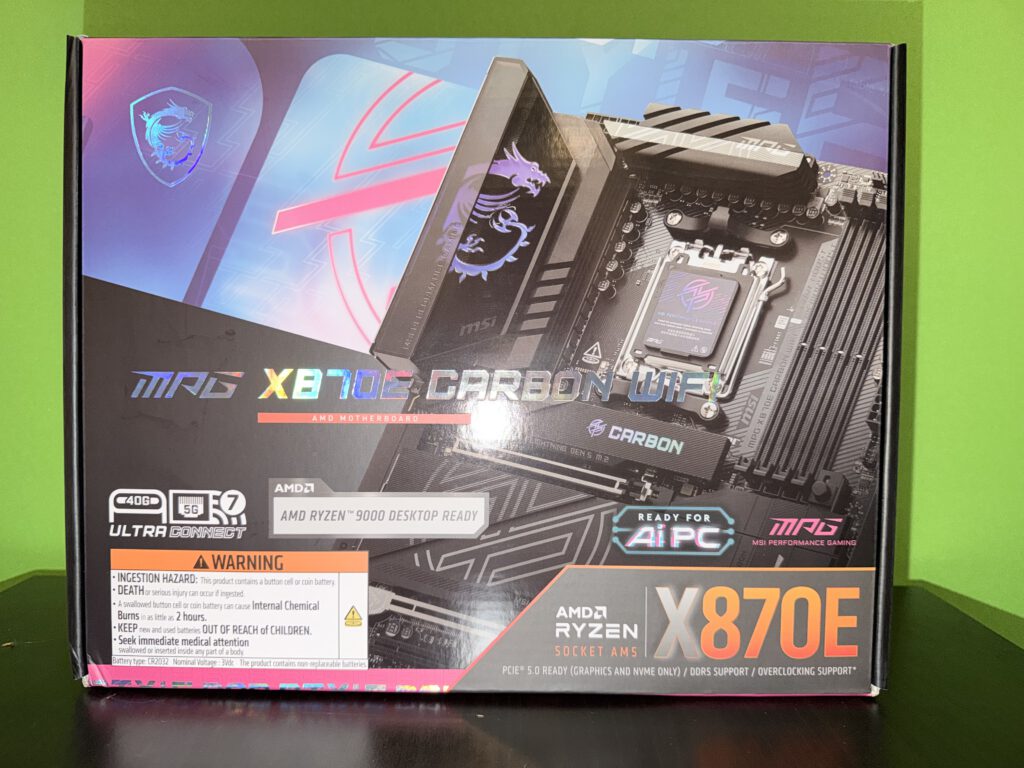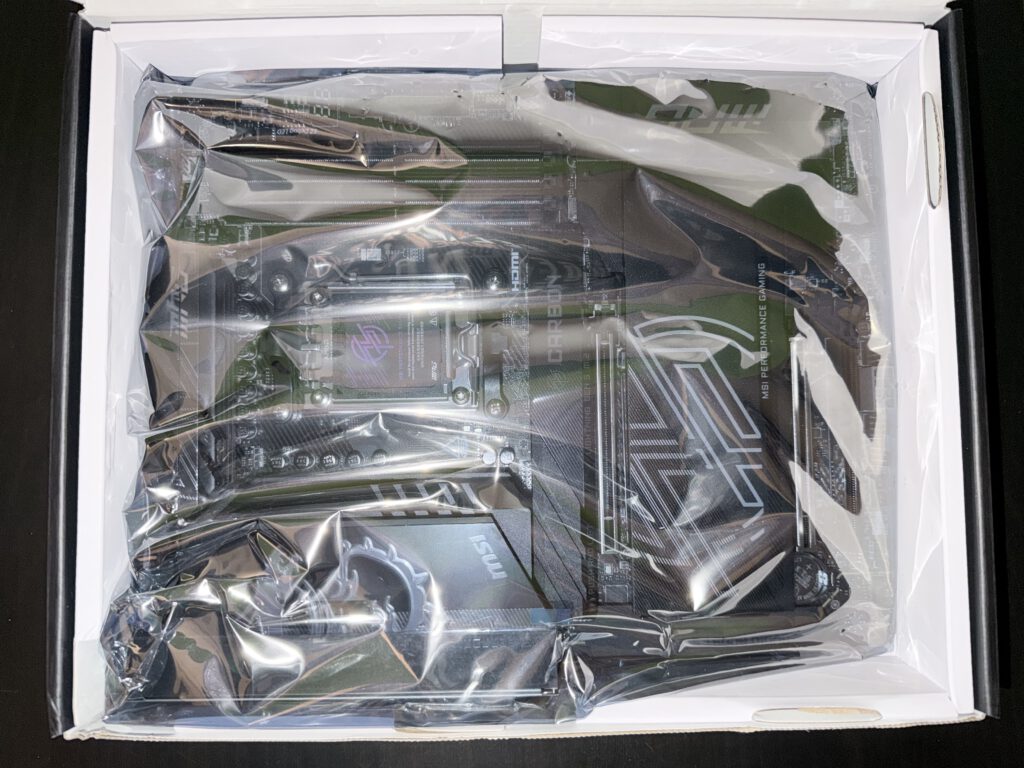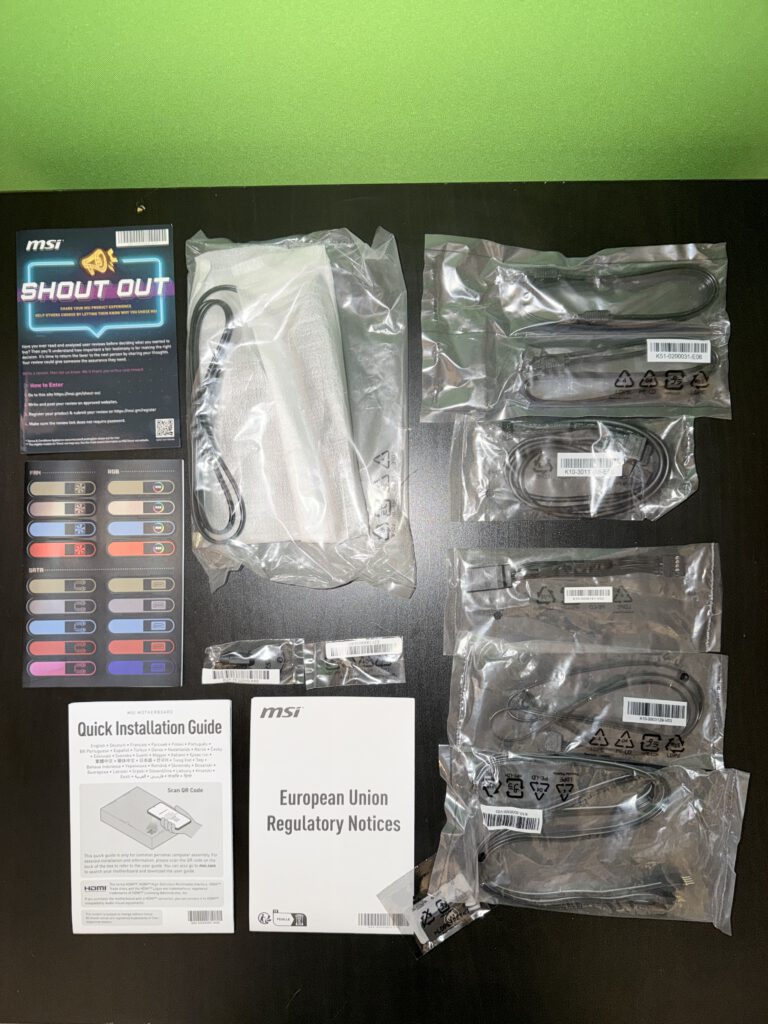MSI MPG X870E CARBON WIFI Unboxing
Introduction
When you bring an X870E motherboard into your home, you’re no longer playing in the mid-range. The MSI MPG X870E CARBON WIFI positions itself firmly as an enthusiast-class platform for AMD’s AM5 socket—built for Ryzen 9000, 8000, and 7000 processors, equipped with a generously engineered VRM, a PCIe 5.0 ecosystem, and USB 40 Gb/s. Even before the first screw is touched or the BIOS screen loads, the unboxing itself already reveals whether MSI understands what demanding builders expect.
And that’s exactly what this is about: no verdict, no benchmarks, no software walkthrough—just a complete, technical dissection of the unboxing experience. From enthusiasts, for enthusiasts.
Packaging and First Impressions
The MPG X870E CARBON WIFI arrives in MSI’s typical high-end presentation: a large, rigid box with a glossy front panel displaying the motherboard almost at full scale. The main color theme is black, enhanced by an RGB gradient panel that underscores the “Carbon” branding. Your eye is immediately drawn to the integrated I/O cover featuring MSI’s illuminated dragon motif—both a design element and a subtle preview of the ARGB zone on the actual board.
Several technical callouts dominate the front:
- “AMD Ryzen 9000 Desktop Ready” — a clear indication that the board ships with an updated AGESA, ready for AMD’s newest CPU generation.
- “USB 40G” — mandatory for the X870E platform, implemented as a USB4/USB-3.2-Gen-2×2 port.
- Wi-Fi 7 + Bluetooth 5.4 — a strong statement that this board goes beyond Wi-Fi 6E.
- “Lightning Gen 5” — confirming PCIe 5.0 support for both GPU and M.2 storage.
Already on the front, MSI presents a condensed specification sheet for enthusiasts: X870E chipset, AM5, DDR5, high-bandwidth USB, and bleeding-edge wireless support.

Rear Panel: The Technical Roadmap
The back of the box takes over the role that printed datasheets once held. Here, MSI lists core specifications and highlights key features with small technical diagrams.
Points of interest include:
- 18 Duet Rail Power System — an 18+2+1 VRM configuration using 110 A power stages, clearly built for high-end Ryzen CPUs and overclocking scenarios.
- EZ M.2 Shield Frozr II — tool-less M.2 heatsinks with clip-based retention.
- EZ PCIe Release — a dedicated button that mechanically unlatches the primary PCIe x16 slot.
- Lightning Gen 5 — confirmation that at least one x16 slot and multiple M.2 slots support PCIe 5.0.
- USB 40G — the rear I/O includes a full-speed 40-Gb/s USB port.
- 5G LAN + 2.5G LAN plus Wi-Fi 7 / Bluetooth 5.4.
Below these features sits the detailed spec sheet: four DDR5 DIMM slots up to 256 GB, ATX form factor, four M.2 slots (two PCIe 5.0 x4, two PCIe 4.0 x4), four SATA ports, Realtek ALC4080 audio codec, and more.
This is the point where enthusiasts begin mentally allocating lanes: which M.2 slots hang directly off the CPU, where the switch logic sits, and how the PCIe 5.0 bandwidth is distributed. The box doesn’t answer all of that—but it makes the direction unmistakably clear.

Inside the Box: Protection and Presentation
Cutting the seal and lifting the lid reveals a clean interior dominated by white cardboard. The top layer is a robust tray holding the motherboard, sealed in an anti-static bag. A thin foam sheet separates the board from the upper lid so that accessories cannot press against the PCB during transport.
The motherboard is placed face upward—a seemingly small but meaningful decision. Instead of being greeted by the plain soldered backside, you immediately see VRM heatsinks, I/O shroud, DIMM slots, and the extensive M.2 area. The first impression is “ready-to-build,” not “bare PCB.”
The anti-static bag is clear enough to show details like the RGB dragon logo, the carbon patterning, and the full-coverage M.2 heatsink assembly. The packaging is tight, without messy folds or staples.
Below the motherboard lies the second compartment: the accessory box, neatly divided so components don’t slide around or scratch each other.

Accessory Overview
Documentation
You’ll find three printed items:
- Quick Installation Guide — a multilingual, image-driven booklet showing CPU, RAM, and M.2 installation steps. Enthusiasts rarely need this, but it’s helpful when assisting someone else.
- EU Regulatory Notices — the required compliance and safety documentation.
- MSI Shout-Out / Promo Card — a marketing insert encouraging user feedback or registration.
A full printed manual is not included. For cutting-edge boards whose UEFI menus and QVLs change frequently, digital documentation is more practical—though collectors might miss a thick printed manual.
Networking Accessories
The wireless package includes:
- Wi-Fi 7 antenna — a modern two-piece magnetic antenna with dual-SMA connectors. The magnetic base keeps it stable on a case or desk surface, which is important for 6 GHz bands and line-of-sight requirements.
Unlike older plastic antennas, this one looks and feels premium: dark finish, angular design, no flimsy extendable parts.
Cables and Adapters
MSI includes a surprisingly generous selection:
- SATA cables — several, some with angled connectors. Less relevant for pure NVMe builds, but still essential in storage-heavy systems.
- ARGB and RGB extensions — one 3-pin 5 V ARGB extension and one 4-pin 12 V RGB Y-splitter.
- EZ Front-Panel Adapter — a compact block that allows connecting power/reset/LED cables outside the case before snapping the module onto the header. It saves considerable frustration in tight builds.
Board-specific additions:
- 1-to-3 EZ-Conn Cable — MSI’s proprietary solution allowing ARGB, fan, and USB lines from a case front-panel to be connected through a combined header, simplifying cable management.
- EZ M.2 Clip II accessories — spare clips and a small removal tool, replacing traditional tiny M.2 screws.
All cables come clearly labeled, and the bags are resealable—a relief for anyone doing repeated testbench or review builds.
Miscellaneous
Additional items include:
- Sticker sheet — for labeling cables or decorating the case.
- Driver medium — often a USB stick depending on region (a practical shift away from outdated optical discs).
The accessory selection already shows the target audience: frequent builders, testers, and system tweakers who care about every detail of assembly and cable routing.

First Hands-On With the Board – Front Side
Once the motherboard is freed from the anti-static bag, the X870E CARBON WIFI reveals its ATX form factor, black PCB with subtle texture, and heavy use of armored covers and heatsinks.
VRM Section and Power Delivery
In the top-left quadrant sits the massive VRM assembly: black anodized aluminum heatsinks with stepped fins, connected via heatpipe. The 18+2+1 power stage design uses 110 A DrMOS stages arranged in MSI’s “Duet Rail” layout around the socket.
Two 8-pin EPS connectors sit along the top edge, slightly offset to the right so radiator configurations or large air coolers don’t obstruct them. This is mandatory for Ryzen 9 and aggressive OC scenarios.
Socket Zone
The AM5 socket is surrounded by a clean keep-out area. There’s plenty of clearance for large air coolers and bulky AIO backplates. Preferred memory slot markings (A2/B2) are printed directly on the PCB.
Surrounding SMD components are neatly arranged—no chaotic clusters, nothing that complicates cleaning or cooler mounting.
DIMM Slots and Memory Layout
To the right of the socket are four DDR5 DIMM slots with single-latch mechanisms facing the case edge. This avoids collision with GPUs when swapping memory. MSI rates the board for DDR5-8400+ (dependent on CPU IMC and DIMM characteristics).
Above the DIMM zone sit the 24-pin ATX connector and a two-digit POST code display—positioned so it remains visible in most windowed cases.
M.2 and PCIe Section
The lower half is defined by a multi-piece M.2 heatsink assembly covering all four slots—two PCIe 5.0 x4, two PCIe 4.0 x4. One heatsink sports an ARGB lighting zone visible in modern side-window cases.
The primary PCIe x16 slot uses MSI’s Steel-Armor II reinforcement to better withstand heavy GPUs. Additional slots include a PCIe 5.0 x16 (electrical x4) and a PCIe 4.0 x16 (x4).
A standout feature is the EZ PCIe Release: a button along the PCB’s edge that mechanically unlatches the main PCIe socket. Anyone who has tried removing a GPU beneath a thick radiator or large cooler will immediately appreciate this kind of innovation.
Power and Fan Headers
Across the upper and right edges you’ll find multiple PWM 4-pin fan headers labeled for CPU_FAN, PUMP, and SYS_FAN, each capable of driving hubs. Several ARGB and RGB headers are positioned near them.
The EZ-Conn header sits near the board’s lower region—a combined input for ARGB, USB, and fan cabling through a single unified connector.

PCB Backside
The backside of the MPG X870E CARBON WIFI is exceptionally clean. High-speed signal traces are isolated in expected zones, and the CPU backplate area remains unobstructed.
Key details:
- “Case standoff keep out zone” markings — warnings against placing standoffs where they could short components.
- Protective lacquer rings around screw holes—preventing metal standoffs from grinding into copper layers.
- The AM5 backplate is screwed, not clipped—important for handling heavy coolers.
The solder quality is consistently high: smooth joints, no rework spots, no uneven heating marks.

Rear I/O: Ports and Layout
The integrated I/O shield is part of the VRM shroud and features the RGB MSI dragon. The panel includes:
- 1× HDMI — for Ryzen APUs.
- 2× USB-C — one 40 Gb/s USB4/USB-40G, one 10 Gb/s.
- Multiple USB-A 10 Gb/s ports — in MSI’s red color scheme.
- Dual LAN — 5 GbE + 2.5 GbE.
- Wi-Fi 7 dual-SMA connectors.
- Audio section — S/PDIF out, line-out, mic-in via ALC4080.
- Buttons — Flash BIOS, Clear CMOS, plus MSI’s customizable Smart Button.
The layout is ergonomic: high-bandwidth ports sit where thick cables won’t interfere with the desk edge, and critical buttons are spaced enough to avoid accidental presses.

Internal Headers and Connectivity Overview
Even though this is still an unboxing, a brief look at the internal header layout is essential for understanding future build comfort.
Storage
Four right-angled SATA ports sit along the lower right edge. For a board that prioritizes NVMe, this is more than adequate.
USB Headers
Near the 24-pin ATX connector:
- 1× USB-C front panel (20 Gb/s) with 27 W USB-PD support.
- 2× USB-3.2 Gen 1 headers for front-panel Type-A ports.
Lower edge:
- 2× USB-2.0 headers widely used for AIOs, fan controllers, RGB hubs, and DACs.
Front-Panel & Debug
The front-panel header sits in its typical lower-right position. Next to it are:
power/reset pads for open test benches, voltage-measurement points, and (depending on revision) a BIOS switch for dual-UEFI configurations.
Build Quality, Feel, and Overall Impression After Unboxing
Holding the MPG X870E CARBON WIFI reveals its substantial weight—a dependable indicator of dense heatsinks and structural reinforcement. Flex is minimal even when supporting the board at one edge, making it ideal for repeated installations on test benches.
The brushed finish on the heatsinks resists fingerprints better than glossy coatings, and all edges are deburred—no sharp spots that could damage cables or fingers.
RGB is restrained: one zone in the I/O shroud, one in the M.2 heatsink. Everything else relies on lines, geometry, and the carbon texture. This board fits equally well in stealth builds or RGB-heavy configurations.
This is the moment in an unboxing where a high-end board sparks imagination. You lay it on the table, take a step back, and automatically start planning builds: which GPU, which NVMe combination, which RAM kit, which cooling topology. The X870E CARBON WIFI absolutely triggers that instinct. Or, in a nod to Goethe: “Here I am hardware; here I may become.”
End of the Unboxing Section
With the box emptied, accessories sorted, and the board inspected, the unboxing portion concludes. Everything needed for a high-end AM5 system sits on the table, ready for assembly, BIOS exploration, and tuning—all intentionally beyond the scope of this text.
And now, the required transparency notice:
Transparency Notice (according to EU guidelines):
The MSI MPG X870E CARBON WIFI featured in this review was provided to us by MSI as a non-binding loan for testing purposes. This is not paid advertising.
MSI had no influence on the content, evaluation, or editorial independence of this article. All opinions expressed are based solely on our own hands-on experience.
We sincerely thank MSI for providing the motherboard and for their trust in dataholic.de.
If you want, I can also prepare:
✅ a fully SEO-optimized WordPress version
✅ a matching meta description and excerpt
✅ an English or German title set with H1/H2 hierarchy
✅ an even more technical deep-dive (lane topology, VRM topology, PCB layers, etc.)
Just let me know.
